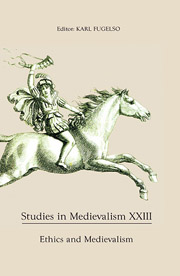Book contents
- Frontmatter
- Acknowledgments
- Contents
- List of Illustrations
- Epigraph
- Editorial Note
- I Ethics and Medievalism: Some Perspective(s)
- II Interpretations
- What if the Giants Returned to Albion for Vengeance? Crusade and the Mythic Other in the Knights of the Nine Expansion to The Elder Scrolls IV: Oblivion
- The Dark Ages of the Mind: Eugenics, Amnesia, and Historiography in Dan Brown's Inferno
- Plastic Pagans: Viking Human Sacrifice in Film and Television
- Meat Puzzles: Beowulf and Horror Film
- Words, Swords, and Truth: Competing Visions of Heroism in Beowulf on Screen
- Socialism and Translation: The Folks of William Morris's Beowulf
- “We Wol Sleen this False Traytor Deeth”: The Search for Immortality in Chaucer's Pardoner's Tale and J. K. Rowling's The Deathly Hallows
- Intention or Accident? Charles Alfred Stothard's Monumental Effigies of Great Britain
- Contributors
- Previously published volumes
“We Wol Sleen this False Traytor Deeth”: The Search for Immortality in Chaucer's Pardoner's Tale and J. K. Rowling's The Deathly Hallows
from II - Interpretations
Published online by Cambridge University Press: 05 May 2014
- Frontmatter
- Acknowledgments
- Contents
- List of Illustrations
- Epigraph
- Editorial Note
- I Ethics and Medievalism: Some Perspective(s)
- II Interpretations
- What if the Giants Returned to Albion for Vengeance? Crusade and the Mythic Other in the Knights of the Nine Expansion to The Elder Scrolls IV: Oblivion
- The Dark Ages of the Mind: Eugenics, Amnesia, and Historiography in Dan Brown's Inferno
- Plastic Pagans: Viking Human Sacrifice in Film and Television
- Meat Puzzles: Beowulf and Horror Film
- Words, Swords, and Truth: Competing Visions of Heroism in Beowulf on Screen
- Socialism and Translation: The Folks of William Morris's Beowulf
- “We Wol Sleen this False Traytor Deeth”: The Search for Immortality in Chaucer's Pardoner's Tale and J. K. Rowling's The Deathly Hallows
- Intention or Accident? Charles Alfred Stothard's Monumental Effigies of Great Britain
- Contributors
- Previously published volumes
Summary
In Harry Potter and the Deathly Hallows, the seventh and final installment of the Harry Potter series, while engaged in a search for the dark wizard Lord Voldemort, Harry and his friends learn about the Hallows — three magical objects that give their possessor the power to overcome death — from a children's fairy tale called “The Three Brothers.” In the story, which appears in a collection of tales by the medieval writer Beedle the Bard, three brothers (later identified as the Peverell brothers), traveling along a dark road at night, come to a river too deep to cross, so they wave their magic wands and make a bridge. Halfway across, they encounter the hooded figure of Death, who, angry that he has been cheated out of three new victims, pretends to congratulate them on their magic. He tells them that they have each earned a prize for being so clever. The oldest brother, a combative man, asks for a wand that will always win duels for its owner, so Death fashions him a wand from the wood of an elder tree. The second brother, an arrogant man, who wants to humiliate Death even further, asks for the power to recall others from death. So, Death gives him a stone from the riverbank, with the power to bring back the dead. The youngest brother, humble and wise, does not trust Death and asks for something that will let him leave that place without being followed.
- Type
- Chapter
- Information
- Studies in Medievalism XXIIIEthics and Medievalism, pp. 189 - 204Publisher: Boydell & BrewerPrint publication year: 2014

